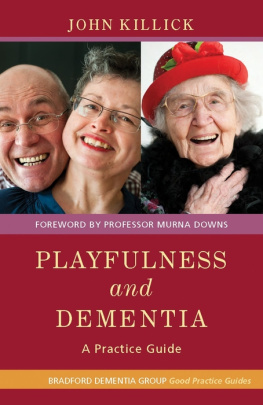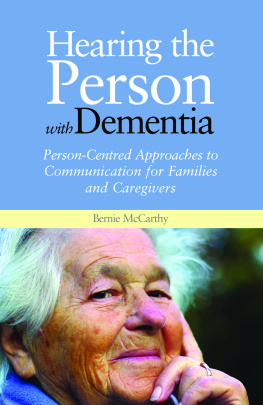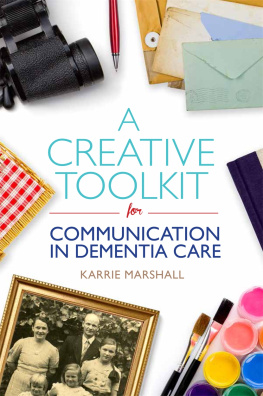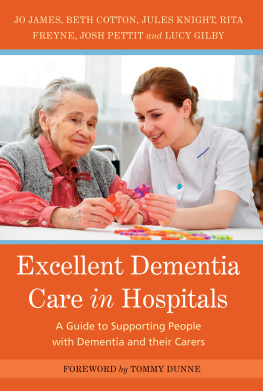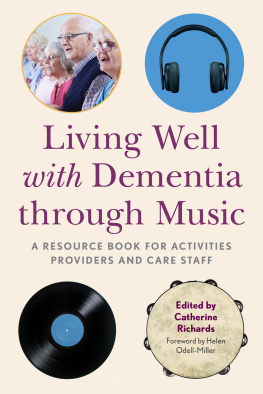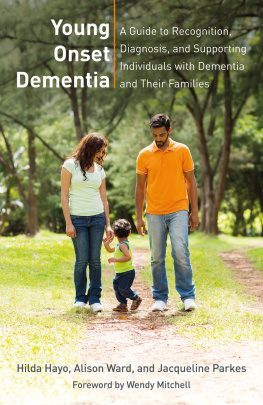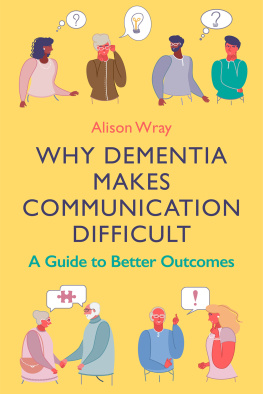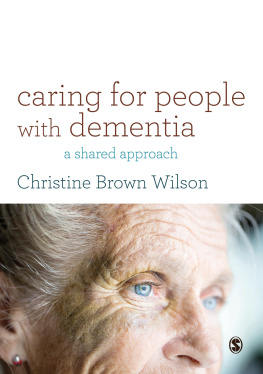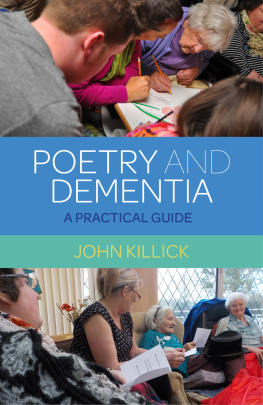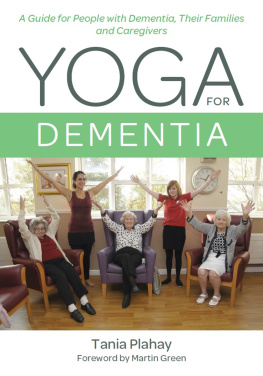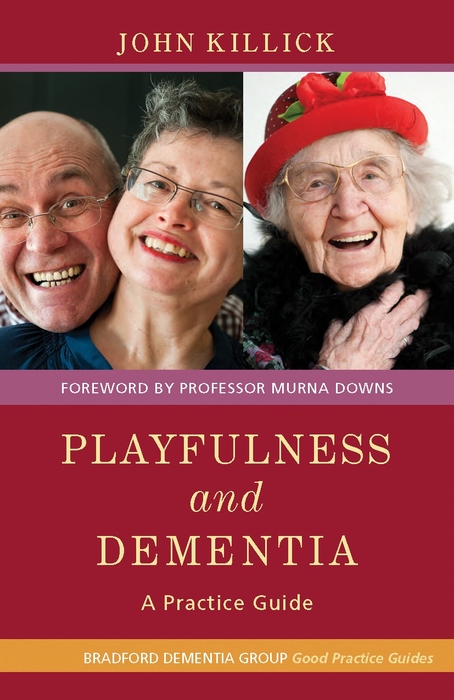Playfulness and Dementia
A Practice Guide
John Killick
Foreword by Professor Murna Downs
Jessica Kingsley Publishers
London and Philadelphia
Small boy by Norman MacCaig on p.17 has been reproduced with kind permission from Birlinn Books.
Claire Craig has kindly given permission for the quotes on p.212.
The quotes from Whitehead (2008), in Chapter 4, have been reprinted with kind permission from Julie Whitehead.
The dementia monologues, in Chapter 6, have been reproduced with kind permission from James McKillop, Nancy MacAdam and John Killick.
The quotes from Knocker (2000) and Knocker (2010), on p.378 and 612, have been reprinted with kind permission from Sally Knocker.
The photographs in Chapter 9 have been reprinted with kind permission from Rende Zoutewelle.
The photographs in the central colour plate have been reprinted with kind permission from Michael Uhlmann (www.uhlensee.de).
First published in 2013
by Jessica Kingsley Publishers
116 Pentonville Road
London N1 9JB, UK
and
400 Market Street, Suite 400
Philadelphia, PA 19106, USA
www.jkp.com
Copyright John Killick 2013
Foreword copyright Professor Murna Downs 2013
All rights reserved. No part of this publication may be reproduced in any material form (including photocopying or storing it in any medium by electronic means and whether or not transiently or incidentally to some other use of this publication) without the written permission of the copyright owner except in accordance with the provisions of the Copyright, Designs and Patents Act 1988 or under the terms of a licence issued by the Copyright Licensing Agency Ltd, Saffron House, 610 Kirby Street, London EC1N 8TS. Applications for the copyright owners written permission to reproduce any part of this publication should be addressed to the publisher.
Warning: The doing of an unauthorised act in relation to a copyright work may result in both a civil claim for damages and criminal prosecution.
Library of Congress Cataloging in Publication Data
A CIP catalog record for this book is available from the Library of Congress
British Library Cataloguing in Publication Data
A CIP catalogue record for this book is available from the British Library
ISBN 978 1 84905 223 8
eISBN 978 0 85700 462 8
Converted to eBook by EasyEPUB
For Sue Benson in gratitude for all her work for people with dementia and their supporters over the years as Editor and Conference and Congress Organiser
Foreword
John Killick must be one of the best known poets working directly with people with dementia. Indeed he has pioneered this approach to amplifying the voice, views and experience of people with dementia. I have had the pleasure of hearing these poems on many, though never enough, occasions. In Playfulness and Dementia, Killick turns his attention to the central importance of play to the well- being not only of people with dementia but also those who care for, and about, them.
There is no doubt that dementia is associated with profound loss and sadness. What is perhaps less well known is the humour, silliness and playfulness which many people with dementia continue to enjoy. Indeed, many family carers and practitioners have told me that one aspect of caring that they find most rewarding is the opportunity for shared fun that they continue to have with people with dementia. It is timely that Playfulness and Dementia be part of our series of Good Practice Guides.
In many ways play is the ideal vehicle for opening the many closed doors experienced when living with dementia. It provides all of us with permission to leave behind the rational, planned and cognitive and embrace the creative, spontaneous and relational aspects of life. In Playfulness and Dementia, Killick seeks to inspire a new generation of playful practitioners by providing an overview of the nature of play and innovative approaches, complemented by accounts of playfulness in practice. I have no doubt that he will do so.
Professor Murna Downs
Series Editor of Bradford Dementia Group Good Practice Guides
University of Bradford
Introduction
This book is in part an act of atonement for a misjudgement. In 1997, Tessa Perrin published an article in The Journal of Dementia Care entitled The puzzling, provocative question of play. I was provoked, and wrote a letter that was published in the magazine. In it I completely dismissed her thesis that play is essential to well-being and stated:
Advocating play with people with dementia is splashing around in the shallows and ignoring the deep water that stretches to the far horizon.
In the years since I have come to completely revise this opinion and now maintain that playfulness has much to contribute to the mental and physical health of those with the condition.
This is a judgement I have come to partly through my own experience, but also from encounters with others: people with dementia, family carers and professionals, some of whom are represented in these pages. The book is in two parts. The first part is made up of chapters on the nature of play and what it has to offer people with dementia, and accounts of various practices that have proved innovative and successful. There is also a chapter contributed by Sarah Zoutewelle-Morris on the playful approach to art and craft activities. The second part consists of five accounts of playfulness in practice two from people with the diagnosis, two by family carers who have gone on to volunteer to work with people with the condition, and one from an actor who has a decades experience of creative approaches using humour; some of these come from edited interviews. I am very grateful to all these contributors, and also to Claire Craig, whose reflections form an important part of Chapter 2. I am also deeply indebted to the German photographer Michael Ullmann for allowing me to include pictures from his wonderful collection on humour and dementia.
It will have become obvious that this is not a book of argument but rather a collection of first-hand accounts and anecdotes, which, taken together, present a working portrait of an important and neglected aspect of dementia. To find those arguments expounded in exemplary fashion, one must turn to Chapter 5 of a book called Wellbeing in Dementia: An Occupational Approach by Tessa Perrin and Hazel May, published in 2000. This, so far as I am aware, is the only serious consideration of the theoretical approach to this subject yet attempted. My endorsement does not extend to the development of Piagets theory of child development applied in reverse to people with dementia that this piece of writing also contains, but otherwise I am happy for my book to be regarded as a practical series of illustrations of what is involved in bringing humour into peoples lives. I have tried to avoid giving instructions of any kind but to let the stories speak for themselves; in this way, I hope that a new generation of playful practitioners will be inspired to take this approach further.
Part I
Chapter 1
What do We Mean by Playfulness?
Play is the unfettering of mind and body; it is without purposefulness; it welcomes the unexpected. In children, it is a natural response to the awareness of being alive in the senses, in collaboration with total unfamiliarity with the environment; it is without boundaries and fearless; it is uncensored and tireless.

